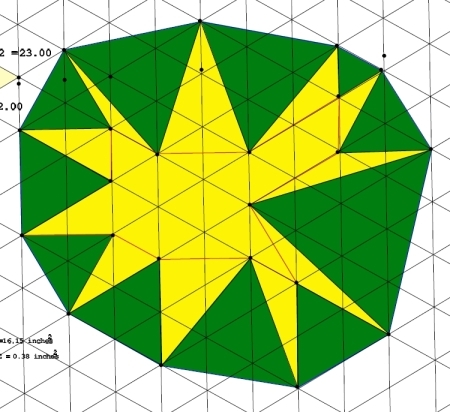John C. Baez's Blog, page 7
November 4, 2024
Polarities (Part 3)
I’m talking about ‘causal loop diagrams’, which are graph with edges labeled by ‘polarities’. Often the polarities are simply  and
and  signs, like here:
signs, like here:
But polarities can be elements of any monoid, and last time I argued that things work even better if they’re elements of a rig, so you can not only multiply them but also add them.
In fact, I argued that it’s even better if polarities are elements of a ‘hyperfield’. But what’s a hyperfield, and why are these good?
First, what’s a hyperring? Br...
November 3, 2024
Polarities (Part 2)
Last time I explained ‘causal loop diagrams’, which are graphs with edges labeled by plus or minus signs, or more general ‘polarities’. These are a way to express qualitatively, rather than quantitatively, how entities affect one another.
For example, here’s how causal loop diagrams us say that alcoholism ‘tends to increase’ domestic violence:

We don’t need to specify any numbers, or even need to say what we mean by ‘tends to increase’, though this leads to the danger of using the term in a ...
November 1, 2024
Polarities (Part 1)
This is a progress report on some joint work with Xiaoyan Li, Nathaniel Osgood and Evan Patterson. Together with collaborators we have been developing software for ‘system dynamics’ modelling, and applying it to epidemiology—though it has many other uses. We’ve written two papers about it, and given plenty of talks:
• Software for compositional modeling.
But the software keeps growing—so it’s time to write another paper or two! First we’re writing one aimed at applied category theorists, wher...
October 31, 2024
Bradwardine’s Rule

I love reading about the medieval physics: you can see people struggling against mental traps, often failing, but still putting up a fight. We shouldn’t laugh at them: theoretical physicists may be stuck in their own traps today! Good new ideas often seem obvious in retrospect… but only in retrospect.
For example: Aristotle argued that a vacuum is impossible, because the velocity of an object equals the force on it divided by the resistance of the medium it’s moving through. A vacuum off...
October 30, 2024
Adjoint School 2025
Are you interested in using category-theoretic methods to tackle problems outside of pure mathematics? Then you might like the Adjoint School. You’ll work online on a research project with a mentor and a team of other students for several months. Then you’ll get together for several days at the end of May 2025 at the University of Florida in Gainesville, Florida. This meeting happens right before the big annual conference on applied category theory, ACT2025.
You can apply here starting Novem...
October 29, 2024
Triangulations of the Sphere (Part 2)
Thurston’s paper Shapes of polyhedra and triangulations of the sphere is really remarkable. I’m writing about it in my next column for the Notices of the American Mathematical Society. Here’s a draft — which is also a much more detailed version of an earlier blog post here.
If you have suggestions or corrections, please let me know: I can try to take them into account before this is due on November 5th. Just don’t ask me to make this longer: I have a strict limit.

If you cut out this awkwar...
October 25, 2024
Triangulations of the Sphere (Part 1)
If you cut out the yellow shape here, you can fold it up along the red lines, and all 11 sharp tips will meet at one point! You’ll get a polyhedron with 12 corners, tiled by equilateral triangles. 5 triangles meet at each corner. There are also places where 6 triangles meet: these places are flat. Some triangles get folded along the red lines.
This may seem like a curiosity. But it shows up in a paper by the great mathematician Bill Thurston, and there’s a lot more to it.
Here’s how he dr...
Triangulations of the Sphere
If you cut out the yellow shape here, you can fold it up along the red lines, and all 11 sharp tips will meet at one point! You’ll get a polyhedron with 12 corners, tiled by equilateral triangles. 5 triangles meet at each corner. There are also places where 6 triangles meet: these places are flat. Some triangles get folded along the red lines.
This may seem like a curiosity. But it shows up in a paper by the great mathematician Bill Thurston, and there’s a lot more to it.
Here’s how he dr...
October 20, 2024
Octoberfest 2024
The Octoberfest is a noble tradition in category theory: a low-key, friendly conference for researchers to share their work and thoughts. This year it’s on Saturday October 26th and Sunday October 27th.
It’s being run by Rick Blute out of the University of Ottawa. However, the meeting is entirely virtual, so you can join from anywhere using this zoom link. The talks will be recorded, and shared publicly later.
Here’s a schedule. All times are Eastern Daylight Time (EDT).
I can’t resist ment...
October 19, 2024
The Helgö Treasure
This Buddha statue was found on an island in a lake in Sweden — a Viking trade and manufacturing center. It dates to the 6th century, and it was made in Kashmir. Amazing evidence of early trade or conquest!
The island is called Helgö, and Vikings worked there from the 6th to 11th centuries. This statue is part of the “Helgö treasure”, a collection that also includes the elaborate head of a bishop’s staff from Ireland, and a bronze ladle from North Africa — probably Egypt.
Vikings were acti...
John C. Baez's Blog
- John C. Baez's profile
- 29 followers






